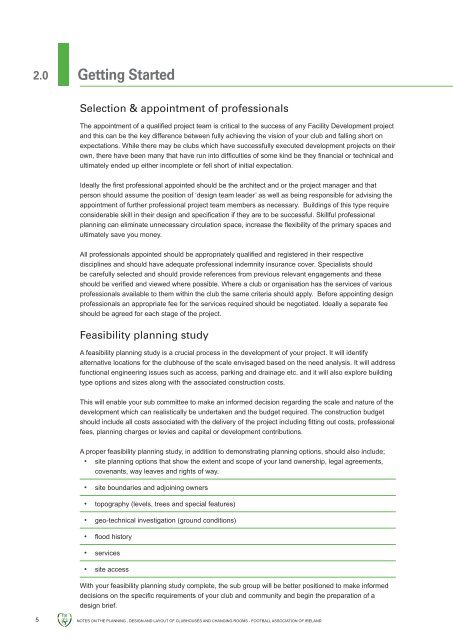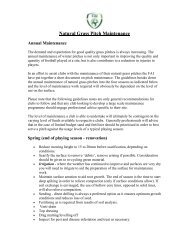Clubhouses & Changing Rooms - FAI
Clubhouses & Changing Rooms - FAI
Clubhouses & Changing Rooms - FAI
Create successful ePaper yourself
Turn your PDF publications into a flip-book with our unique Google optimized e-Paper software.
2.0<br />
Getting Started<br />
Selection & appointment of professionals<br />
The appointment of a qualified project team is critical to the success of any Facility Development project<br />
and this can be the key difference between fully achieving the vision of your club and falling short on<br />
expectations. While there may be clubs which have successfully executed development projects on their<br />
own, there have been many that have run into difficulties of some kind be they financial or technical and<br />
ultimately ended up either incomplete or fell short of initial expectation.<br />
Ideally the first professional appointed should be the architect and or the project manager and that<br />
person should assume the position of ‘design team leader’ as well as being responsible for advising the<br />
appointment of further professional project team members as necessary. buildings of this type require<br />
considerable skill in their design and specification if they are to be successful. Skillful professional<br />
planning can eliminate unnecessary circulation space, increase the flexibility of the primary spaces and<br />
ultimately save you money.<br />
All professionals appointed should be appropriately qualified and registered in their respective<br />
disciplines and should have adequate professional indemnity insurance cover. specialists should<br />
be carefully selected and should provide references from previous relevant engagements and these<br />
should be verified and viewed where possible. Where a club or organisation has the services of various<br />
professionals available to them within the club the same criteria should apply. before appointing design<br />
professionals an appropriate fee for the services required should be negotiated. ideally a separate fee<br />
should be agreed for each stage of the project.<br />
Feasibility planning study<br />
a feasibility planning study is a crucial process in the development of your project. it will identify<br />
alternative locations for the clubhouse of the scale envisaged based on the need analysis. it will address<br />
functional engineering issues such as access, parking and drainage etc. and it will also explore building<br />
type options and sizes along with the associated construction costs.<br />
this will enable your sub committee to make an informed decision regarding the scale and nature of the<br />
development which can realistically be undertaken and the budget required. the construction budget<br />
should include all costs associated with the delivery of the project including fitting out costs, professional<br />
fees, planning charges or levies and capital or development contributions.<br />
a proper feasibility planning study, in addition to demonstrating planning options, should also include;<br />
• site planning options that show the extent and scope of your land ownership, legal agreements,<br />
covenants, way leaves and rights of way.<br />
• site boundaries and adjoining owners<br />
• topography (levels, trees and special features)<br />
• geo-technical investigation (ground conditions)<br />
• flood history<br />
• services<br />
• site access<br />
With your feasibility planning study complete, the sub group will be better positioned to make informed<br />
decisions on the specific requirements of your club and community and begin the preparation of a<br />
design brief.<br />
5 notes on the PlanninG , desiGn and laYout of <strong>Clubhouses</strong> and ChanGinG rooms - football assoCiation of ireland



